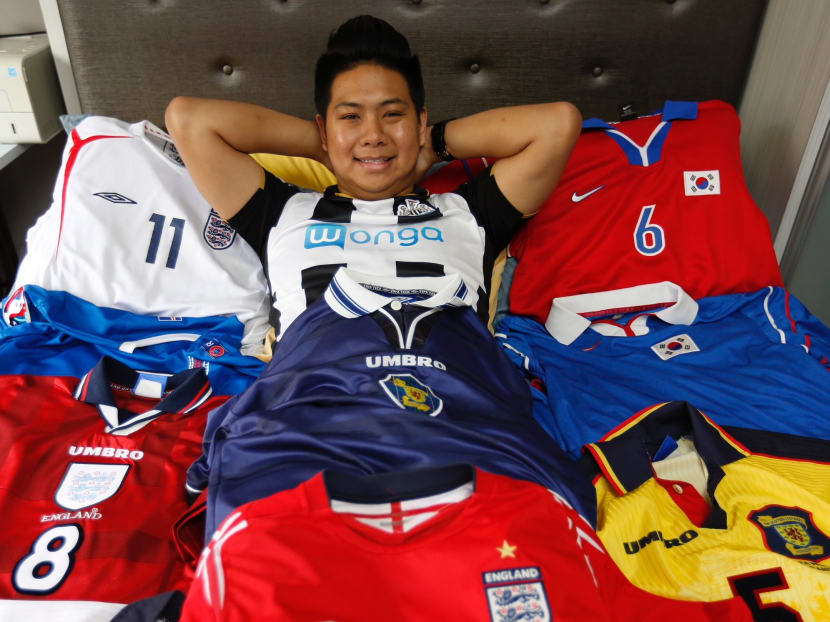Germany, Brazil jerseys hottest items for 2018 World Cup, but Nigeria and Iceland also score among fans
SINGAPORE — Once again, Germany and Brazil head the list of hottest World Cup jerseys for the Fifa World Cup, as football fever heats up ahead of the June 14 to July 15 tournament in Russia.

Football jersey collector Terence Ong, 32, spends about S$140 on every jersey he gets after customising them with patches and names. He owns about 150 jerseys.
SINGAPORE — Once again, Germany and Brazil head the list of hottest World Cup jerseys for the Fifa World Cup, as football fever heats up ahead of the June 14 to July 15 tournament in Russia.
But there are surprise favourites in the mix this time, with Nigeria’s highly-sought after kit — featuring a retro green-and-white zigzag pattern — and Egyptian Mohamed Salah’s jersey also in hot demand, said football jersey retailers here.
Mr Zulfarid Mohammad Zin, store manager of Premier Football’s Suntec outlet, said they are selling at least one or two Germany and Brazil jerseys a day, but demand is also strong for smaller teams such as Croatia and World Cup debutants Iceland — the underdog favourites who lit up the 2016 UEFA European Championship with their indomitable spirit.
Les Bleus’ World Cup jersey is also in higher demand this year, said Weston Corporation co-owner Rajbir Singh Chopra.
There is also a new favourite in town to join the likes of household names such as Portugal’s Cristiano Ronaldo and Lionel Messi of Argentina. On the back of a prolific run to the Champions League final against Real Madrid, Liverpool’s Salah is also popular among fans.
Weston, which offers on-the-spot printing of players’ names on jerseys, has seen a spike in fans asking for Salah’s name. While football memorabilia shop La Vanita did not bring in any Egypt national team jerseys, its owner Steve Dadlani said many fans have asked for it because of Salah.
The quadrennial World Cup is a money reaper for jersey sellers, who see a spike in sales of between 30 and 200 per cent during the month-long period. Some corporate companies even buy jerseys in bulk to hand out to their employees, said the retailers.
Due to huge worldwide demand, local sellers have to order and bring in their consignments months in advance. This can cause trouble at times, especially when big teams are unexpectedly knocked out of the tournament, or fail to qualify.
For instance, Weston placed an order for more than 1,000 Italy jerseys last July ahead of the official launch in October. But they were left with excess stock when the four-time World champions failed to qualify for the tournament later that month.
“We still have Gianluigi Buffon’s jersey,” said Mr Chopra. “People still buy them but not as much. Their sales usually are in the top five.”
Sales usually picks up during or after the World Cup, said Mr Zulfarid, and it depends on which teams do well. He added that jersey stores like his have to take a business gamble.
“That is the pattern nowadays. People wait to see which team goes through, rather than supporting any specific one,” he said.
Champion Sports owner Anil Kumar said Singaporeans “usually follow the teams who win and players who score”. Design also plays a major role, with Nigeria’s being the prime example this year.
The “Naija” kit, modelled after the one worn by the country’s revered 1994 team — who made their World Cup debut in the United States and fell just short of a quarterfinal spot — became a pop-culture phenomenon when Nike unveiled it in February. The jersey was so hotly-sought after that it sold out online within three minutes of its launch last week. Champion Sports managed to bring in 20, and sold them all within two days.
Mr Anil said: “It’s just because the design is nice. We brought in 200 Nigeria jerseys three World Cups ago and no one bought any.”
“I would get the jersey myself if I could,” Mr Zulfarid said with a laugh, adding that customers come into his store “every single day” to ask for it.
While the sellers also have online portals, they said fans usually prefer brick and mortar stores when purchasing brand new jerseys.
“They want to see the colour and design, feel the fabric, try on the sizes,” added Mr Anil. “You only buy secondhand jerseys online that become rare. They are usually collectors’ items.”
GETTING KITTED OUT
Major football tournaments such as the World Cup can be costly for avid jersey collectors such as Mr Terence Ong, 32.
The communications manager, who has collected jerseys for about 20 years, spends about S$140 on each one as he customises them with patches and names. He forked out close to S$1,000 on nine jerseys for the 2016 European Championship.
Mr Ong has been a stalwart England supporter since he began watching their matches with his father. Besides the English kits, he also buys those from underdogs such as Iceland, and well-designed ones.
“For me, the draw is to collect as many football memorabilia as possible… at the same time, you can parade it when you wear it out,” said the Newcastle United fan.
“It’s about showing the various colours of football. It’s more than just your Germany, Spain, Manchester United, Liverpool – there are so many other teams out there.”
One of his most prized jerseys is the England away kit from the 1998 World Cup, the first tournament he remembers watching. He bought it for £50, or about S$90, on eBay two months ago.
For jersey collector and Les Bleus supporter Johan, who only wanted to be known by his first name, his most treasured item is his Zinedine Zidane’s jersey from the 2006 World Cup. The 37-year-old remembers his idol’s last international tournament vividly, and, of course, his infamous headbutt during the final.
Mr Johan has shelled out about S$300 on average every World Cup since 1998 and usually buys three to four jerseys. This year, the Liverpool FC fan will add France, Argentina, Iceland, and Egypt to his collection.
He added: “I’m from a footballing (fan) family so I guess it’s natural to collect them.”








